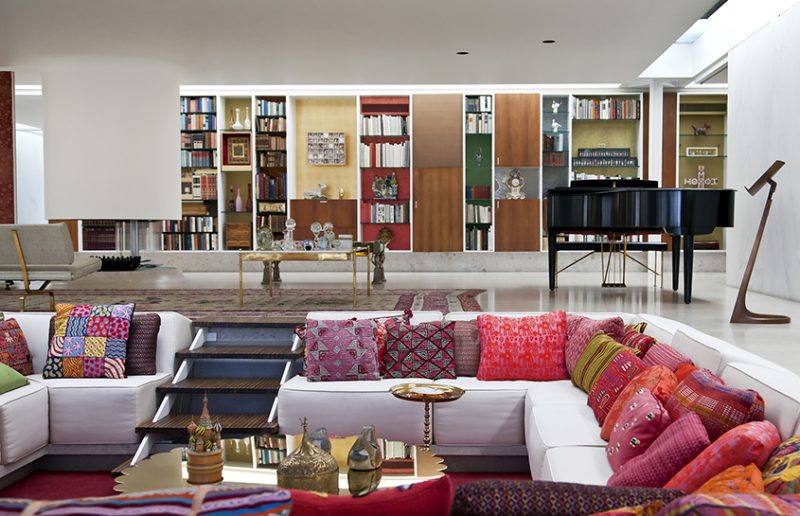Best known for designing the Gateway Arch in St. Louis, Washington Dulles International Airport, and the General Motors Technical Center, architect Eero Saarinen’s legacy is mostly comprised of large buildings and landmarks. But on the rare occasion Saarinen did design a house, he went all-in—as evidenced by the Miller House, a beacon of residential mid century modern architecture in Columbus, Indiana.
“Saarinen only designed seven houses, most of which were done in collaboration with others such as Charles Eames or his father, Eliel Saarinen,” says Shelley Selim, curator of design and decorative arts at the Indianapolis Museum of Art at Newfields. “It’s an incredibly rare gem.”
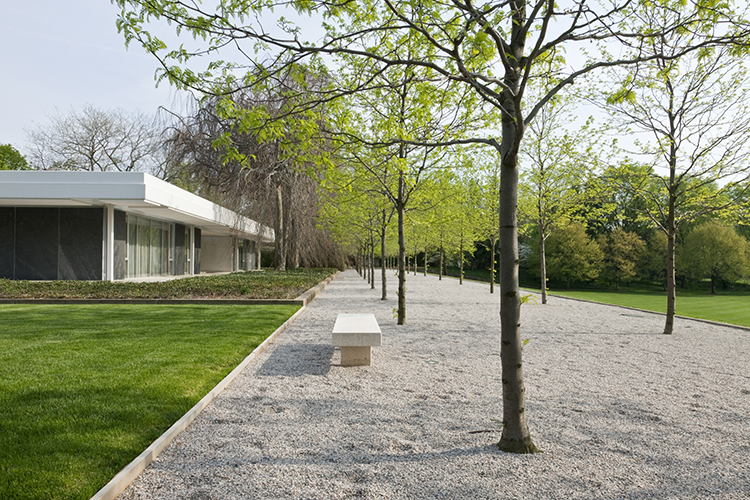
Adding to that cache is the fact that the Miller House is the only surviving domestic interior designed by Alexander Girard that is open to the public, plus the fact that the landscape was designed by Dan Kiley, whom Selim calls “one of the pioneers of the modernist landscape.” Thanks to the vision of this dream team, the Miller House is often regarded in the same breath with the Farnsworth House and the Glass House as shining examples of residential modernism.
“These three designers worked together in collaboration to create a total work of art,” says Selim. “All three of them were operating at the peak of their careers in the 1950s, and it’s one of those rare moments where there is a confluence of different minds and ideas that come together in a beautiful building.”
Mies-ian Vibes and Special Touches
Clocking in at approximately 6,800 square feet, the Miller House displays what Selim calls a “Mies-ian” vibe, calling on International Style architectural staples such as an open, rectilinear layout; flat roof; glass and stone walls; and a seamless connection to the surrounding landscape (which includes an alleyway of honey locust trees, crowned by Henry Miller’s “Draped Reclining Woman” sculpture). The house was commissioned back in 1953 by J. Irwin and Xenia Simons Miller, and gifted to the Indianapolis Museum of Art at Newfields in 2009 after Xenia’s passing.
While the exterior of the Miller House is significant, it’s the interior design that “brings the space to life,” Selim says. “Girard infused this interior with color and playfulness and folk art from around the world. The interior design tells a story about the Miller family itself in a lot of ways.”
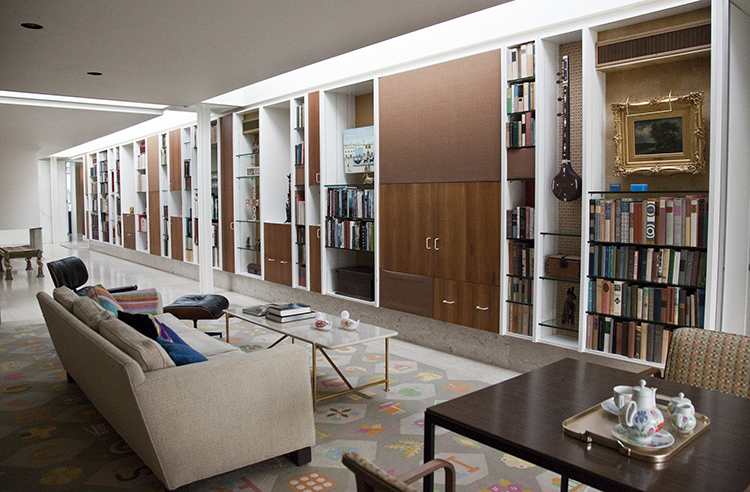
According to Selim, Xenia and Girard bonded over their love of folk art, which is reflected on a 50-foot storage wall displaying an eclectic array of objects from Mexico, Asia, and Eastern Europe. Girard also designed a custom rug that acts as a family history of sorts, with lozenge-shaped cells displaying various iconography—such as the Miller family initials; Eero Saarinen’s initials; an apple as a nod to the on-site orchard; an elephant to represent their Republican affiliation; a church to reflect their deep faith; and butterflies to honor Xenia’s love of the winged creatures.
“The rug acts as a biographical visual memento,” Selim says. “Girard would have had to know the Millers extremely well to know all of these facts about them. The rug provides a really wonderful insight into Girard’s relationship with the Millers; they were extremely important clients for him.”
Having had curatorial oversight for the last four years, it’s hard for Selim to play favorites, but one of her favorite objects in the home is a three-story dollhouse designed by Girard to mimic the Miller House in a Victorian style. The dollhouse is located west of the house’s conversation pit and features ceramic figures and furniture made by Girard’s brother, Italian artist Giancarlo Girard (aka “Tunsi”).
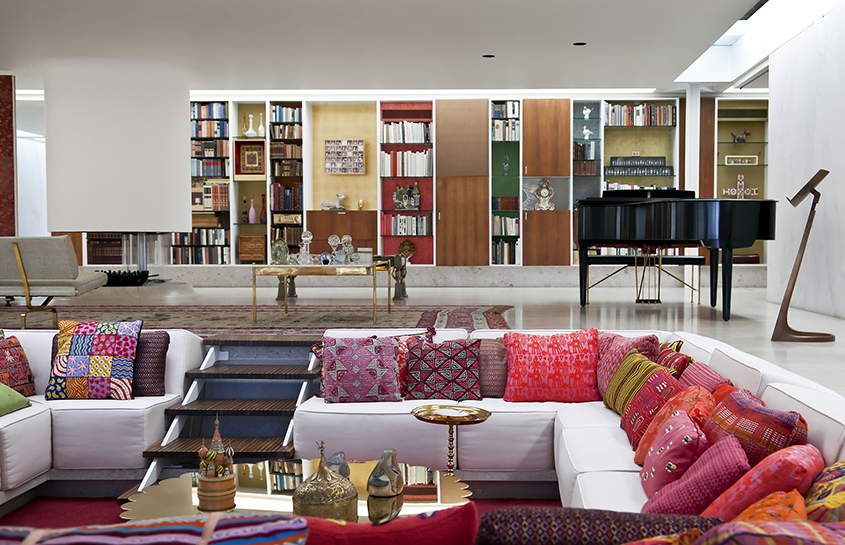
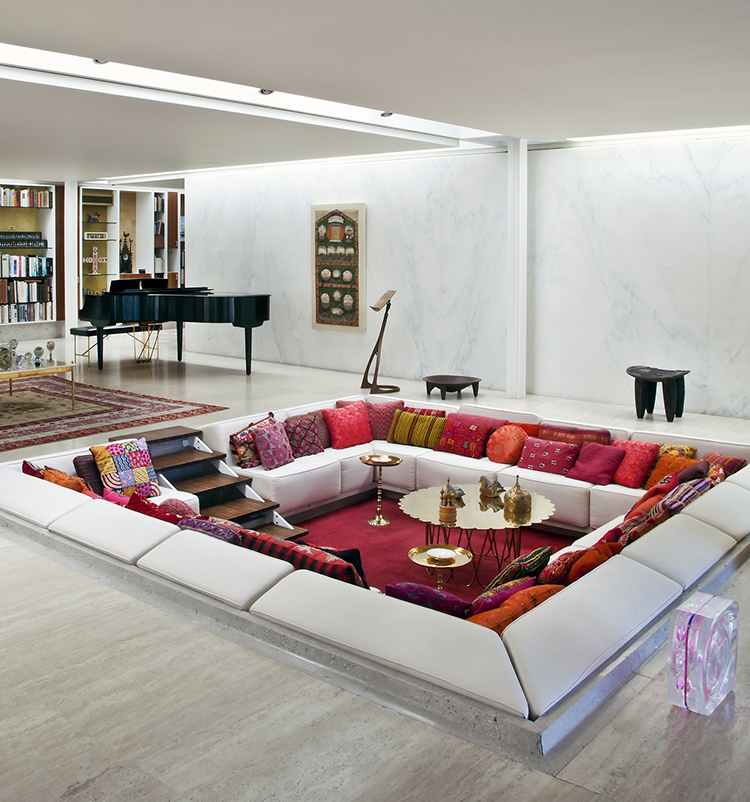
Other notable features of the house include a cylindrical floating fireplace and what Curbed called “the world’s first conversation pit.” Having worked as an assistant curator at Cranbrook, Selim is also struck by the parallels with the Saarinen House designed by Eliel Saarinen.
“Even though Eero and Eliel Saarinen had very different styles and aesthetic approaches, there are definitely similarities between the Saarinen House and the Miller House,” says Selim, who lived in the Saarinen House’s servants’ quarters when she was a Cranbrook fellow. “They include the dining room layout, design of the dining room table, the vantage point from the dining room to the backyard, and curtains being used to divide spaces.”
The Legacy Continues
Though the house has been closed for part of 2020 due to COVID-19, the Miller House is once again open for tours with a special treat in store. Previously covered with a tarp and not open to the public, the pool—replete with Richard Schultz pool furniture—is now on display. “It’s a great addition to the tour and the ambience of the home,” says Selim.
Looking forward, Newfields has obtained a $170,000 Keeping It Modern grant from The Getty Foundation to come up with a conservation management plan for the home. One of the top priorities will be replacing the roof, which is prone to moisture seeping in due to the home’s extensive skylight system (on which Miller installed UV filters to protect the artwork inside).
“It’s an amazing gem that’s been preserved for so long,” says Selim. “The Miller House is one of the greatest examples of modernist domestic architecture that exists in the world today.”
And of course, don’t forget to follow us on Instagram, Facebook, Pinterest and YouTube for more Atomic Ranch articles, house tours, and ideas!

